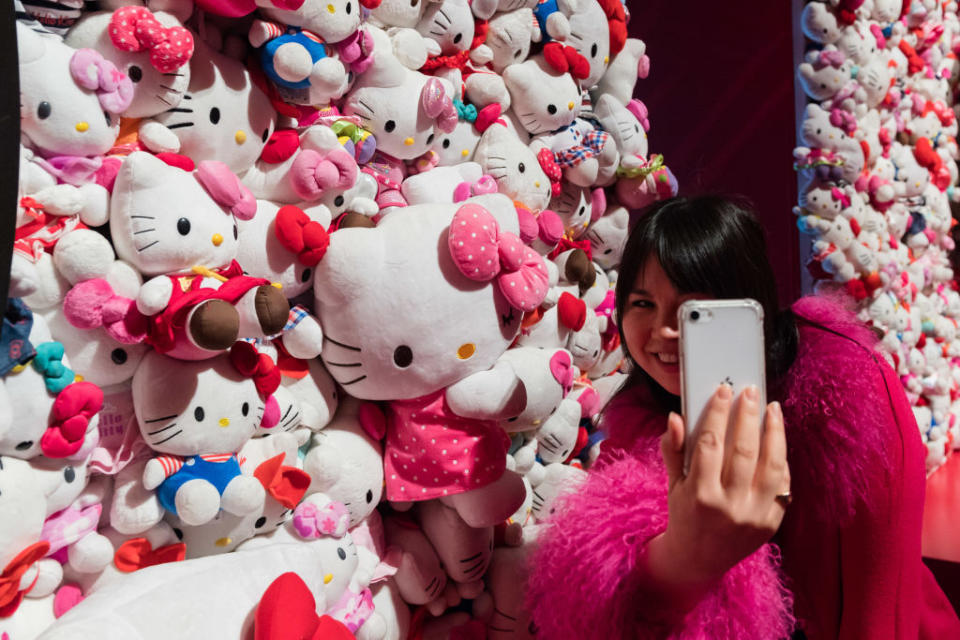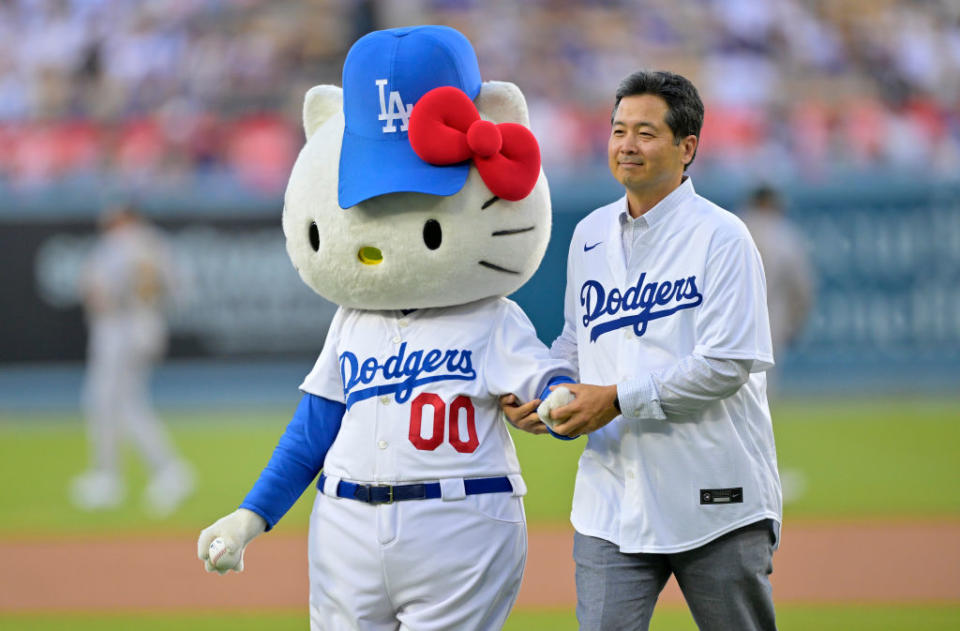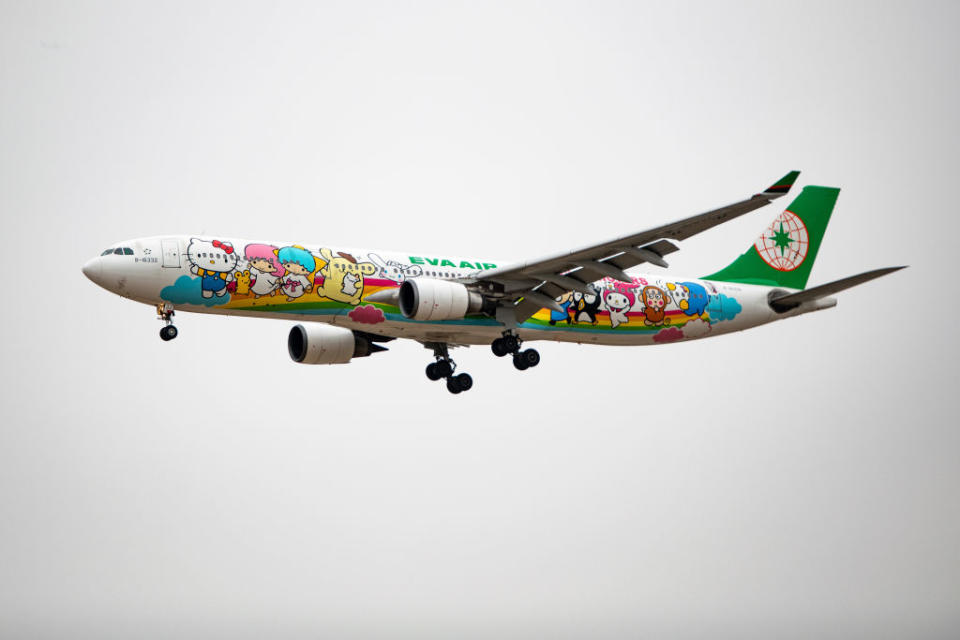Sanrio CEO on the Key to Hello Kitty’s 50 Years of Success

A staff member poses with Hello Kitty at the CUTE exhibition in London, on January 24, 2024. CUTE is the first major exhibition to examine the complex "power of cuteness." Credit - Wiktor Szymanowicz—Future Publishing/Getty Images
She’s one of Japan’s best-loved creations, adorning some 50,000 products sold across 130 countries and earning billions of dollars for parent company, Sanrio. But it’s important to note what she’s not: Hello Kitty isn’t a cat, nor is she, in fact, Japanese. She is an anthropomorphic feline-like British girl born in the leafy suburbs of London, according to the official narrative. She stands as tall as five apples and weighs the equivalent of three. She likes baking cookies, though her favorite food is mama’s apple pie. Not having a mouth, she instead speaks from the heart, with a saccharine catchphrase: “You can never have too many friends!”
Making friends has never been a problem for Hello Kitty, for whom 2024 marks half a century as one of the world’s most recognizable cultural icons. Countless millions have grown up surrounded by Hello Kitty stickers, socks, and pillowcases, while celebrity fans include pop royalty Mariah Carey and Lady Gaga; Katie Perry even sports a Hello Kitty tattoo, while Avril Lavigne released a (widely panned) homage single titled Hello Kitty in 2013. Other admirers are more august; on Tuesday, King Charles and Queen Camilla hosted Japanese Emperor Naruhito and Empress Masako at a state banquet at Buckingham Palace, where the British head of state used his welcome speech to also “wish a very happy birthday to… Hello Kitty!”
The breadth and longevity of Hello Kitty’s fandom renders her one of history’s greatest marketing phenomena: a subject not just adored but pawed over and dissected by industry execs desperate to discover the secret sauce—the meow factor, if you will—behind her enduring appeal.“It's very difficult to point out just one reason,” says Sanrio CEO Tomokuni Tsuji, grandson of founder Shintaro Tsuji, in his only foreign media interview to mark Hello Kitty’s 50th anniversary. “We’re amazed. To develop a character that sustains for 50 years is not an easy thing.”
It’s not hyperbole to say that Tsuji and Hello Kitty are practically family. Although 14 years younger than Hello Kitty, Tsuji remarkably shares her birthday, Nov. 1. It was on this day in 1974 that Sanrio designer Yuko Shimizu first sketched the adorable white bobcat with a red bow. The following year she appeared on her first product: a clear vinyl coin purse that retailed for 220 yen, or a little under a dollar at the time. That success soon mushroomed into an empire encompassing toys, games, animations and all manner of consumer gewgaws.
“Since I was born, I was surrounded not only by Hello Kitty but all of the Sanrio characters, so I literally grew up with them,” Tsuji says. “There was not a day when I didn’t see Hello Kitty.”
Sanrio—today worth $4.6 billion —was founded in 1960 originally as Yamanashi Silk Company. Two years later, Shintaro Tsuji diversified into selling rubber sandals and quickly noticed how a simple flower adornment made one product much more desirable than another. Sanrio expanded into a range of stationery and consumer trinkets that epitomized Japan’s budding kawaii, or “cute” subculture. “There's nothing very special about the products,” confesses Tsuji. “It's things that you might use in your daily lives, like a lunchbox or little pouches to store stuff. But it's always surrounding you, close to you in your daily life. Therefore, they connect to your memories.”

Designers praise Hello Kitty's abstract quality and simplicity, which has allowed Sanrio to retain its creative vision while adapting to changing trends and tastes. Although the broad contours of Hello Kitty—real name, “Kitty White”—retain a timeless simplicity, diehard fans monitor the glacial evolutions to her appearance. Each year, there could be a slight shift in the patina of her overalls, the occasional presence of stripes, the thickness (or sometimes absence) of her black outline. But certain characteristics are immutable: a red bow over her left ear, no mouth, and an ascetic, almost ethereal, expression.
Hello Kitty's modernist abstraction and lack of facial features allow her to be interpreted in different ways by different people. No laughing, surprise, or tantrums. Her expressionless visage provides a blank canvas for the beholder to impart their own feelings; when you’re feeling silly, she doesn’t upbraid with an uber-cool pout; if upset, she doesn’t mock with fatuous grin. She is ever-present yet unobtrusive, projecting serenity but not judging. In 1996, Hello Kitty was pictured winking for the first time, and it's a look that gained traction over the 2000s.
“That kind of ambiguity is really enhanced by the wink,” says Christine Yano, an anthropology professor at the University of Hawaii at Manoa and author of Pink Globalization: Hello Kitty's Trek Across the Pacific. “You can have humor, you can have irony, you can have sexual innuendo. It's a very clever and effective marketing strategy.”

Tsuji says that Hello Kitty's simplicity and lack of a specific narrative makes her a more versatile and relatable character than, say, Mickey Mouse. But there’s a lot of detail to lap up. Hello Kitty is the daughter of George and Mary White and lives in a two-story house in London. A perpetual third grader, she has a twin sister, Mimmy, and a pet cat, Charmmy Kitty, and a boyfriend, Dear Daniel, who also happens to be an actual cat (a fact immortalized in a 2022 Saturday Night Live sketch.)
I don’t believe Walt Disney ever revealed Mickey’s blood type, but we know Hello Kitty is Type A. The reason we know is that fortune-telling through blood types is a popular method of personality and compatibility testing across East Asia and especially in Japan, where it is known as ketsueki-gata and akin to horoscopes, resulting in most celebrities and even fictional characters disclosing this information alongside height and birthdate. (FYI, Hello Kitty is a Scorpio while Dear Daniel, born May 3, is a Taurus. It will never work!)
This blending of Japanese mores and European backstory isone of the many ways that Hello Kitty serves as a bridge between East and West. Tsuji says he doesn’t know why his grandfather chose to make her British—“Hello Kitty was born 50 years ago and I'm only 35!” he laughs—though prevailing wisdom is that Japanese products didn’t have a great reputation in the 1970s, whereas London fashion and design was deemed aspirational. In any case, the decision to obscure Hello Kitty’s true roots fostered some curious cultural traits. In fractious 1970s America, at a time when most Asian-Americans were trying their damndest to assimilate, Hello Kitty served as a secret cultural touching point. “It became a statement of identity for Asian-American girls,” says Joshua Paul Dale, a professor specializing in kawaii studies at Chuo University in Tokyo. “Because not many people knew Hello Kitty was from Japan, but they knew.”
Soon enough, Hello Kitty-mania led to several animated TV series for kids, as well as an exercise video, and two officially licensed theme parks, Harmonyland and Sanrio Puroland. And it wasn’t long before the product range had expanded beyond dolls, stickers, and milk flasks to adult-focused home appliances like televisions, toasters, computer equipment, and even cars.
At different times, Hello Kitty has had her own line of fine wines, diamond jewelry, MasterCard debit card, while Bank of America began offering Hello Kitty-themed checking accounts in 2009. Fender launched a Hello Kitty Stratocaster electric guitar; Taiwan’s EVA Airways even rolled out an Airbus A330-20 plastered in Hello Kitty livery. She became so mainstream that, in 2008, Hello Kitty was named Japan’s tourism ambassador to mainland China and Hong Kong. She’s also a UNICEF Children’s Ambassador and even launched White House bids in 2012 and 2016.

Not all adult associations have been positive, though. In 2007, Thai police guilty of minor infractions—arriving late for shifts or parking in the wrong place—were forced to wear a Hello Kitty armband and a pair of linked hearts as punishment. Feminists equated Hello Kitty’s absence of a mouth with a lack of voice or agency and have chafed with the entire concept of kawaii, believing it perpetuates the infantilization of women and female submissiveness. It’s a contentious issue, given Japan ranked 118th among 146 countries in the World Economic Forum’s 2024 gender gap report. Japanese society has long fetishized youth, and trends like kogal—dressing in schoolgirl uniforms—and even Lolita fashion are perfectly mainstream. Yet while outsiders may perceive these subcultures as submitting to male stereotypes, inside Japan it’s less clear-cut. “Adherents say they do not dress up for men, they do it for themselves,” says Dale. “So it is a hyper-feminine style, but it's for women themselves, and actually Japanese men recognize that.”
In truth, the roots of kawaii go deeper still. There had been kawaii art since the 1603 to 1868 Edo period, when cute motifs in Japanese prints and paintings abounded, including cats acting like people and puppies caked in snow frolicking under trees. But kawaii got a boost in the early 20th century when education became universal, but girls were schooled separately. This enabled them to create their own world fueled by an explosion of popular girls’ magazines. While Mickey and Goofy were created by men and aimed at everyone, a hyper-cute culture proliferated in Japan specifically catering to young females. The kawaii phenomenon paused during the war years but stormed back in the 1970s, when a resurgent Japan experiencing a baby boom, combined with a cultural tradition of gift-giving, led to an upsurge in demand for cheap, pretty knick-knacks . “Sanrio was just really good at making designs that kids wanted, particularly girls,” says Dale. “That's when that unique kawaii look got more solidified.”
What’s next for Sanrio is the big question. Since taking over as CEO in 2020, Tsuji has prioritized diversifying into other characters and refocusing from branding to entertainment. The existing 150-odd Sanrio stores in Japan and dozens more overseas have shifted from being where characters are bought to where they are experienced, cognizant that a large chunk of sales now take place online, where AI has been enlisted to help root out the abundance of cheap counterfeits. Whereas Hello Kitty was created in an artist’s studio, today Sanrio prioritizes fan input at the ground floor of character development, incorporating feedback on potential traits via its dedicated app prior to launch “Sanrio’s ultimate philosophy of ‘getting along together’ hasn’t changed,” says Tsuji. “However, the process will be different between myself and how my grandfather did it.”
More generally, Hello Kitty is taking a back seat as befits her age. Back in 2013, Hello Kitty accounted for 99% of Sanrio’s North American business; today, it’s 60% and just 30% worldwide. In the 2024 official ranking of Sanrio characters, Hello Kitty sits in lowly fifth place, with top dog—quite literally—Cinnamoroll, a white male puppy “born on a cloud in the faraway sky” with a curled up tail like its namesake pastry. There’s also a push into modern toys like reactive dolls as well as smartphone-based video games. “We see a drop in Hello Kitty because the other characters are growing,” says Tsuji. “But that doesn't mean the Hello Kitty brand revenue itself is coming down.”
In fact, Sanrio just set a new record for revenue last year at $622 million, with operating profit of $161 million. Rather than rely just on Hello Kitty, Tsuji says the new impetus is for a diverse portfolio where even if one character’s popularity starts to decline, there are others to plug the gap. “We need to have a good balance,” he says. “It could be characters like Hello Kitty which last for a long time, or maybe suddenly emerging characters from some animation or game. We want to make sure there's not peaks and troughs, but peak after peak.”
Will he ever produce another global phenomenon to rival a certain white cat-girl? Tsuji shrugs. “There's no silver bullet, there's no magic success,” he says. The key to creating characters, he reveals, is “you need to actually enjoy and experience the entertainment yourself. And you need to try to enjoy the challenge.” And no doubt make a few friends along the way.
Write to Charlie Campbell at charlie.campbell@time.com.

 Yahoo Finance
Yahoo Finance 